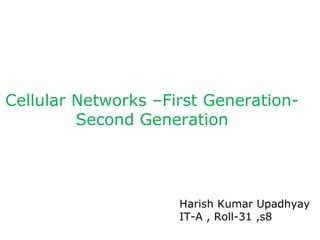
Cellular network,1st generation,2nd generation
- 1. Cellular Networks –First Generation- Second Generation Harish Kumar Upadhyay IT-A , Roll-31 ,s8
- 2. Cellular Networks Cellular networks are wireless WAN that establish a connection between mobile users. The network is comprised of many cells that typically cover 2 to 20 miles in area. The communications are wireless within the cell only. Many initial cellular network were predominantly analog because they were primarily targeted for voice users. The use of cellular networks to support digital applications is increasing rapidly.
- 3. Cellular Concept Another advantage of several small cells instead of a single transmitter=> frequency reuse: better efficiency R cell radius and D distance at which a frequency can be reused with acceptable interference
- 4. Cellular Network Organization Areas divided into cells o Each served by its own antenna o Served by base station consisting of transmitter, receiver, and control unit o Band of frequencies allocated o Cells set up such that antennas of all neighbors are equidistant (hexagonal pattern)
- 5. Cellular Network Organization Areas divided into cells o Each served by its own antenna o Served by base station consisting of transmitter, receiver, and control unit o Band of frequencies allocated o Cells set up such that antennas of all neighbors are equidistant (hexagonal pattern)
- 6. Frequency Reuse Adjacent cells assigned different frequencies to avoid interference or crosstalk Objective is to reuse frequency in nearby cells o 10 to 50 frequencies assigned to each cell o Transmission power controlled to limit power at that frequency escaping to adjacent cells o The issue is to determine how many cells must intervene between two cells using the same frequency
- 8. Cellular Systems Terms Base Transceiver Station (BTS) also known as Base Station (BS)– includes an antenna, a controller, and a number of receivers Mobile telecommunications switching center (MTSC) also known as Mobile Switching Center(MSC)– connects calls between mobile units Two types of channels available between mobile unit and BS o Control channels – used to exchange information having to do with setting up and maintaining calls o Traffic channels – carry voice or data connection between users
- 9. First Generation First-generation cellular networks were introduced in the 1980s are primarily intended for voice . These networks are very slow less than 1 kilobits per sec(kbps). The key idea of 1G cellular networks is that the geographical area is divided into cells ,each served by a base station.Cells are so small that frequency reuse is possible in the near by cells. They are primarily based on analog communications. Each phone has 32 bit serial number and 10 digit phone number in its PROM.
- 10. Security issues with 1G Analog cellular phones are insecure. Anyone with an all-band radio receiver can listen in to the conversation.There are also theft of airtime. A thief uses an all-band radio receiver that is connected to a comuter.This computer can record the 32-bit serial numbers and phone numbers of subscribers when calling The thieves can collect a large database by driving around and then can go into business bu reprogramming stolen phones and reselling them .
- 11. Second Generation Second generation cellular network introduced in 1980s ,are based on digital transmission. Primarily intended for voice they also support fax and email services at low bit-rate(8 to 9 kbps). The higher 2G systems use GSM(Global System For Mobile Communication) and low-tier system is intended for low-cost,low-power,low-mobility. Digital transmission offer several benefits overe analog : Voice,data such as email and fax can be integrated into a single system. Better compression can lead to a better channel utilization. Error correction code can be used for better quality. Sophisticated encryption can be used.
- 12. Differences Between First and Second Generation Systems Digital traffic channels – first-generation systems are almost purely analog; second-generation systems are digital Encryption – all second generation systems provide encryption to prevent eavesdropping Error detection and correction – second- generation digital traffic allows for detection and correction, giving clear voice reception Channel access – second-generation systems allow channels to be dynamically shared by a number of users
- 13. REFERENCES : www.wikipedia.org McGrawHill :Mobile computing
- 14. Thank You Open to questions ..